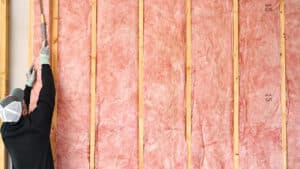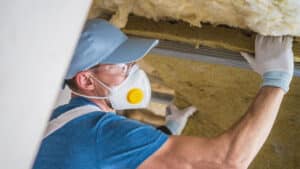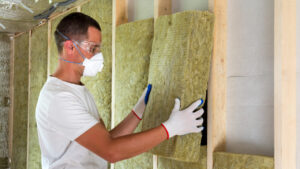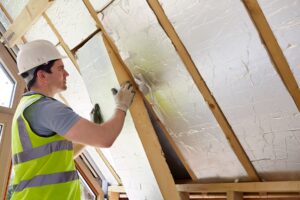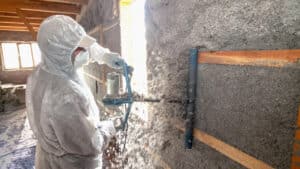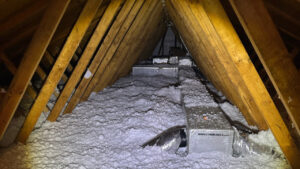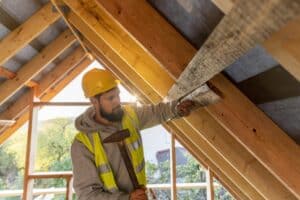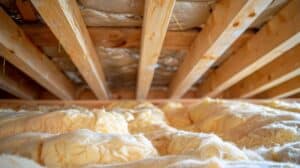Insulation acts like a thermal barrier for your home, and without sufficient insulation, comfort and energy efficiency fall to the wayside.
Signs of inadequate insulation are often subtle, yet they starkly impact your utility bill and the comfort of your living space.
From fluctuating temperatures to the uninvited presence of pests, a poorly insulated home has more to tell than meets the eye.
By identifying these telltale signs early, homeowners can take decisive action to improve their homes’ insulation, thereby enhancing energy savings and indoor comfort.
Keep reading to discover the eight indicators that suggest it might be time to call in the experts at Universal Insulation Doctor.
#1: Higher Than Necessary Energy Bills
Residents often overlook the subtle hints that a home may be lacking sufficient insulation, yet one of the most telling signs is an energy bill that doesn’t seem to make sense. When a house is poorly insulated, heating and cooling systems have to work overtime to maintain a comfortable environment, leading to excessive energy consumption. The link between inadequate home insulation and heightened utility bills in Virginia Beach and its surrounding areas cannot be understated.
Universal Insulation Doctor has served hundreds of residents in Newport News and Chesapeake and has found that fluctuating indoor temperatures is one of the most common symptoms they find on home checks. A well-insulated home is able to sustain the indoor climate, aligning with the set temperatures on the thermostat. Here are some things to look for in your home:
- – Unexpected spikes in the energy bill despite consistent usage
- – A heating system struggling during the winter months, particularly in climate zones prone to ice dams
- – Increased reliance on cooling units throughout the summer despite moderate outdoor temperatures
- – Energy assessments revealing poor performance in areas such as attic insulation or crawl space condition
The connection between poor insulation and energy waste extends beyond the immediate discomfort it brings to occupants. Over time, regions like Virginia Beach witness substantial heat loss through areas such as attic spaces, window frames, and foundation walls. This loss is not merely a seasonal concern, but a continuous drain on the energy efficiency of the home, reflecting heavily on the energy bill.
Conscious of these issues, the team at Universal Insulation Doctor encourages property owners to consider an insulation inspection. Shockingly high energy costs may well be a cry for help from inadequate crawlspace insulation or a signal that it’s time for basement waterproofing. Being proactive can lead to a significant reduction in energy loss and utility costs that benefit both the homeowner and the environment.
#2: High-Temperature Variations Between Rooms
Experiencing drastic temperature shifts as one moves from room to room often serves as a red flag for under insulation:
| Location | Expected Temperature | Actual Temperature | Possible Cause |
|---|---|---|---|
| Living Room | Comfortable, as set | Unusually warm | Poor wall insulation |
| Bedroom | Comfortable, as set | Noticeably cooler | Inadequate attic insulation |
| Kitchen | Comfortable, as set | Steady as expected | Proper insulation |
| Bathroom | Comfortable, as set | Colder near the window | Inefficient window frames |
Such disparities not only impact the comfort levels within the home but also highlight the potential inefficiencies in the insulation work. In particular, inadequate attic insulation or gaps in wall insulation are often to blame.
Universal Insulation Doctor commonly identifies this issue during energy audits. Specialists have found that thermal imaging can detect areas where insulation is deficient, causing some rooms to retain heat while others lose it quickly.
Residents of Newport News and nearby locales should consider the implications of these temperature variances, as they might indicate that crucial areas like knee walls and floor joists haven’t been properly insulated. The result is an uneven heating and cooling distribution that could be rectified with comprehensive home insulation services.
#3: Mice and Bugs on Your Property
Unwelcome guests such as mice and insects often invite themselves into homes, and their presence could be indicative of inadequate insulation. Crevices in the home’s exterior or unsealed gaps provide easy access for pests seeking shelter and warmth. During home inspections in Virginia Beach and Newport News, entry points are often found in under-insulated areas like crawl spaces and attics.
Effective insulation does more than keep out the cold; it also acts as a barrier against these tiny intruders. The tendency for bugs and rodents to settle in poorly insulated homes is a sign of the need for an insulation upgrade.
Pest infestations are not just a nuisance but can also contribute to health risks and structural damage. The droppings and nesting habits of critters can ruin insulation materials, compounding energy inefficiency and leading to additional problems. Homeowners recognizing such concerns should see this as a flag to consult with an insulation contractor to assess and remedy the compromised barriers with proper home insulation.
Engaging a professional team to air seal and insulate your home can disrupt the habits of these unwanted tenants. Universal Insulation Doctor offers services designed to secure the vulnerable points in a property’s insulation system, deterring pest ingress and bolstering the home’s overall energy efficiency, comfort, and health standards. They even created a variation of their own insulation called Pest Guard to which is designed specifically to make your home unliveable for any insects. It’s become extremely popular with homes who experienece frequent insects in their living space.
#4: Home Stays Cold Regardless of Heater Being On
Even with the heating system working tirelessly, a persistent chill within the confines of a residence suggests insulation deficiencies. Despite a fully operational heating system, the warmth generated seems insufficient. This disparity should alert homeowners to potential gaps in their insulation coverage.
Insulation acts as a thermal barrier, and when properly installed, it retards the surrender of heat to the colder exterior. Yet, if homeowners feel an unwavering draft or coldness underfoot, it’s likely that critical areas like the attic floor or crawl spaces are lacking in insulation. Substandard insulation in these areas can cause a home to remain cold, undermining the efficiency of even the most robust heating installation.
An under-insulated home is ill-equipped to maintain a consistent temperature, leading to the constant operation of the heating system, as evidenced by heater activity failing to translate to increased air warmth. Clients in Norfolk and Chesapeake have experienced marked improvements in their living spaces once Universal Insulation Doctor, the home insulation installer, addressed these hidden insulation problems.
Common issues such as hollow wall cavities or inadequate floor insulation are often the unseen culprits of a home’s inability to retain heat. Professional insulation contractors specialize in pinpointing and rectifying these inefficiencies, transforming icy interiors into cozy retreats that effectively retain the heat produced by the home’s heating system.
#5: Home Gets Excessively Hot in Summer
Many homeowners accept the summer heat as an inescapable discomfort, yet an excessively hot home may indicate a more profound problem: inadequate insulation. The sun’s intensity can infiltrate living spaces, especially in areas of high humidity, creating unbearable indoor conditions. The intense heat buildup suggests that areas like the attic and walls could lack the insulation needed to shield the interior from the scorching outdoor temperatures.
The struggle against sweltering conditions is often an unnecessary battle if the home’s insulation barriers are intact. Sufficient attic and crawl space insulation work in harmony to significantly reduce heat transfer, maintaining cooler indoor climates throughout the hottest days:
| Area | Ideal Insulation Impact | Result with Poor Insulation |
|---|---|---|
| Attic | Blocks heat from penetrating downward | Rooms below overheat |
| Walls | Keeps indoor temperatures stable | Heat seeps through, raising room temps |
| Crawl Space | Prevents ground heat transfer | Floor becomes a heat conductor |
Without proper insulation, even the most advanced cooling systems cannot combat the heat pumped into an inadequately insulated house. It’s not simply a matter of discomfort; excessive heat in the home puts a strain on air conditioning units, leading to higher energy bills and potential system overloads.
Addressing the root of the overheating with strategic insulation enhancements can establish a refreshing and cost-effective summer living environment.
#6: Cold Drafts
When winter winds whistle through the home, it’s a telltale sign that home insulation may be insufficient. Drafts are more than just a minor annoyance; they’re strong indicators that warmth is escaping through gaps in a home’s protective shield. If it’s been awhile since your last insulation check-up a draft might be the sign you need that it’s time.
Cold drafts typically emerge from specific areas within a home:
| Common Draft Source | Location in Home | Insulation Deficiency |
|---|---|---|
| Door Frames | Entrances and Exits | Air leaking through unsealed edges |
| Window Frames | Panes and Sills | Incomplete air sealing or aging insulation |
| Attic Floor | Under the Roof | Lack of sufficient attic insulation |
| Electrical Outlets | Walls | Gaps around fixtures |
Drafts not only make a space uncomfortable but also signal a direct hit to energy efficiency. Air leakage points enable the cold outside air to infiltrate the home, prompting heating systems to work harder. This is particularly problematic in climate zones like Norfolk’s, where chillier temperatures demand reliable indoor warmth.
By addressing the root cause, typically found at junctures like doorways and window frames, the insulation contractor solidifies a home’s thermal envelope. This process, in turn, diminishes the occurrence of cold drafts, benefiting the occupants’ comfort and their wallet.
#7: Cold Floors, Ceilings and Walls
A touch of the hand can often reveal truths about a home’s thermal protection; cold floors, ceilings, and walls are tangible evidence of under insulation.
Surfaces that are cold to the touch typically indicate that the insulative layer between the interior living space and the exterior environment is lacking. This subpar insulation allows heat to rapidly escape, resulting in uncomfortable living conditions and ramping up the need to utilize heating systems extensively.
In areas like Norfolk, where temperature fluctuations can be quite marked, maintaining consistent warmth throughout a residence is essential. Because proper insulation is crucial for this check in flooring above unheated spaces and adjacent to the foundation walls for cold.
Addressing these cold surfaces goes beyond installing mere floor insulation; it encompasses a comprehensive evaluation and improvement of the entire home’s insulation. With their targeted solutions, homeowners experience not only warmer floors, ceilings, and walls but also improved overall energy efficiency.
#8: Water leaks in The Attic
Discovering water leaks in the attic can be a jarring revelation for homeowners, pointing to possible shortcomings in the home’s insulative barrier.
Identifying such leaks is a compelling sign that your attic insulation may require urgent attention.
Water intrusion not only risks damage to a home’s structure and belongings but also hints at latent energy inefficiencies that exacerbate heating costs during the winter.
Ignoring this symptom can be costly, as a well-insulated attic is key to maintaining warmth and reducing overall energy expenditure.
How Insulating Your Home And Staying Warm Will Save You Money in Winter?
Securing a well-insulated home directly translates into cost savings during winter’s chill. As Universal Insulation Doctor, based in Virginia Beach, firmly asserts, proper insulation reduces the reliance on heating systems, effectively lowering utility bills and conserving energy across Norfolk, Newport News, and Chesapeake regions.
Strategically insulating living spaces, particularly the attic, minimizes heat loss, allowing for more consistent temperatures and decreased energy consumption. This reinforces the home’s natural warmth and brings about noticeable financial relief during the colder months, a benefit any savvy homeowner would cherish.
Where to Insulate in a Home
Knowing where to insulate is crucial for maximizing a home’s thermal efficiency. Priority spots often include the attic, walls, crawlspace, and basements, where gaps can lead to significant heat escape and water ingress.
Insulation best practices recommend targeting the perimeter of living spaces, ensuring that floor joists and ceiling rafters are properly insulated. This preventative measure effectively reduces the likelihood of water leaks and energy transference, maintaining a comfortable, cost-effective home environment year-round. Installer best practices also include addressing and insulating the crawlspace to further improve energy efficiency and prevent water damage.
Frequently Asked Questions
How can higher than necessary energy bills be a sign of under insulation in my home?
Higher than necessary energy bills can be a sign of under insulation in a home because inadequate insulation allows for heat transfer, causing the heating and cooling systems to work harder and consume more energy.
Why do I experience high temperature variations between rooms if my home is under insulated?
One possible reason for experiencing high temperature variations between rooms in an under-insulated home is that the home insulation is not effectively trapping and regulating the heat, resulting in uneven distribution throughout the house.
What is the connection between mice and bugs on my property and under insulation in my home?
Mice and bugs can be attracted to your property and find their way under your home’s insulation in search of food, shelter, and nesting opportunities.
Why does my home stay cold regardless of the heater being on if it is under insulated?
One possible reason why a home stays cold despite the heater being on is if it is under insulated. Inadequate home insulation can allow heat to escape, making it difficult for the heater to effectively warm the space.
Why does my home get excessively hot in the summer if it is under insulated?
Under insulation can lead to heat transfer from the outside to the inside of your home, causing it to become excessively hot in the summer. Insufficient home insulation fails to effectively block the transfer of heat, resulting in high indoor temperatures.

